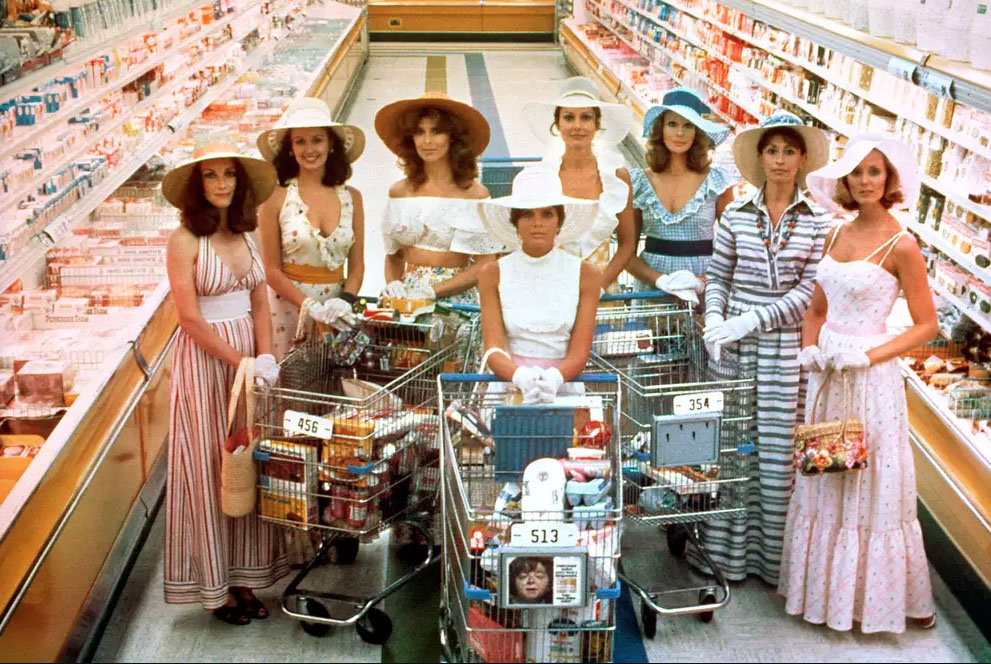The first movie adaptation of Ira Levin’s 1972 novel (he also penned Rosemary’s Baby) is a chilling affair. Best described as a satirical horror thriller, it channels both pro- and anti-feminist sensibilities of the time, as well as tapping into the humans-as-robots sci fi trope explored by Westworld. “Stepford Wife” has entered our language as a term to describe any woman who is spookily submissive, and “Stepford” is a derisory term for any suburb that is stultifyingly bland. The film has stood the test of time – worryingly so – and still has the power to chill the bones of any woman who has been told to “be nice”, “behave” and “stay out of the men’s way”.
The Movie
Joanna Eberhart (Katharine Ross) is living the dream in the dynamic heart of 1970s New York, with two lovely children, and a husband, Walter (Peter Masterson) who seems supportive of her fledgling career as a photographer. She’s part of a generation of women who have expectations far beyond motherhood and wifedom, and she wants it all. However, when Walter announces that they must relocate to Stepford, Connecticut, Joanna has no choice but to follow — it’s 1975.
Stepford is idyllic: large houses populate leafy lanes, occupied exclusively by the white, middle-class, cheerful and content. The women of Stepford possess bovine calm, are immaculately turned out, and dedicate themselves to the needs of their husbands and children. Joanna thinks she’s going to be bored, until she starts hanging out with fellow new arrival Bobbie (Paula Prentiss), slurping down cocktails and giggling at the bedroom habits of their neighbors.
Meanwhile, Walter has joined the Men’s Association. The local patriarchs meet in a sinister old house every evening to drink brandy, smoke cigars and compare notes on their pre-Stepford careers as engineers, sculptors, and robot designers. Walter seems like a nice enough guy, but he shares his new friends’ concerns about the disintegration of family life – thanks to those raucous feminists who think husbands should do more of the washing up – and he becomes a fully paid-up member of the club, although he sheds a few tears en route.
Joanna and Bobbie can’t quite believe how brainless their new female friends are, especially as the most cursory amount of research (in those days, that involved looking in newspapers) reveals that they used to be career women and activists. When they try to organize a ‘Consciousness Raising Session’ the discussion gets bogged down in the merits of various cleaning products. Bobbie worries that there’s something in the water, but her investigation with the EPA comes to an abrupt halt when she too becomes Stepfordized. In one seminal scene, Joanna goes looking for her kids at Bobbie’s house and has to confront the full horror of what’s been done to her friend.
Joanna is left alone to deal with the truth about what’s happening to women in the old house on the hill, and what her inevitable fate will be. The final irony is that her maternal concern for the safety of her children seals her doom: she has the chance to flee, but won’t leave without them.
Reception
The (mostly male) movie critics of the day found the movie tough going, complaining that it was too blunt and attacked the obvious targets with little finesse. That’s true, but the movie bears reviewing through a historical perspective, and as a testament to what has, and hasn’t changed in the battle for gender equality since then. The power of Levin’s original satire is that it could still, sadly, happen today. William Goldman’s script is light on the sci-fi aspects of the original novel, but goes hard on the binary gender politics of the era. This is a true suburban horror story, shot through with a sly, cruel sense of humor. While the Men’s Association mansion is wreathed in darkness and thunderstorms, as befits the nefarious activities that take place within its walls, some of the most horrific things happen in serene suburban sunlight (Carol Van Sant’s car accident, Charmaine’s submission, Joanna finding her children gone). The Men’s Association might be crude caricatures of the male WASP establishment, but they’re definitely the winners here — and they continue to win to this day. There’s no last-minute reprieve for Joanna, no final triumph of the underdog. She must submit to the hegemony, become the epitome of what the men on the hill think a woman should be.
Sequels
There are three nondescript sequels that revisit the premise: Revenge of the Stepford Wives (1980), The Stepford Children (1987) and The Stepford Husbands (1996). Perhaps the most chilling aspect of the 2004 remake, starring Nicole Kidman, was that it was supposedly a comedy, with an evil Glenn Close masterminding the robot replacements. In a truly post-feminist world, where equal pay and opportunities are automatic and global, and childrearing and household care are a matter of choice, not gender, then yes, it could be funny. Or perhaps if female filmmakers were put in control of the adaptation and were able to explore the way patriarchy still harms women and non-binary individuals today. Not until then.
